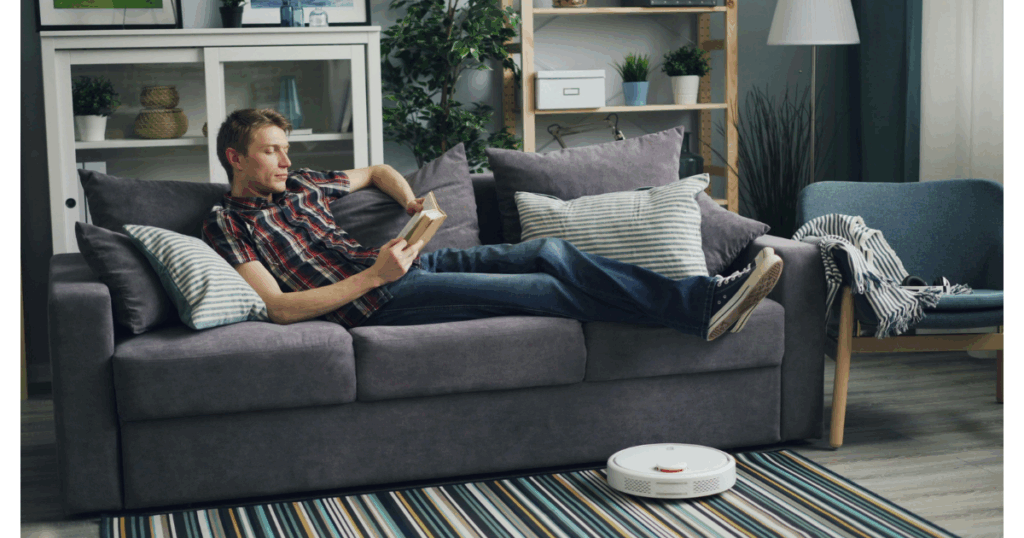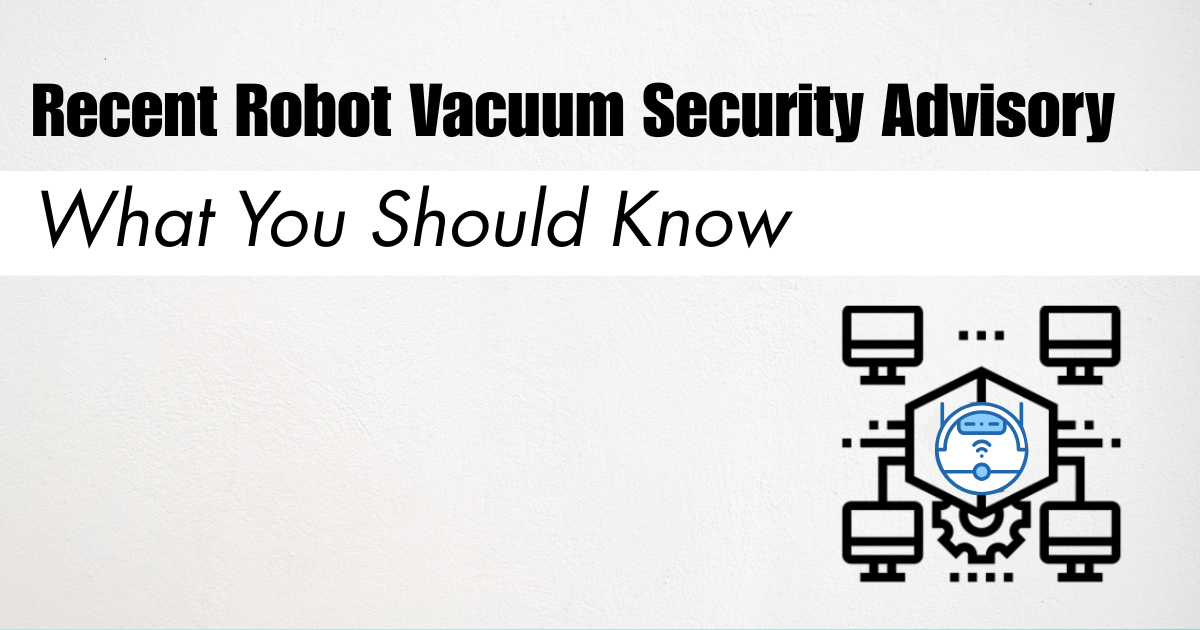Recently, the U.S. Cybersecurity and Infrastructure Security Agency (CISA) issued an advisory about a vulnerability in one popular robotic vacuum model that might let hackers take control of the vacuum and even spy on you [cisa.gov]. No real-world cases of this have been reported, but if it still makes you nervous, don’t worry. In this post, we’ll explain in simple terms what the issue is, what it means for you as an owner, and how to stay safe.
What’s the Issue with This Robot Vacuum?
Think of your robot vacuum as a little computer on wheels. Like any computer, it runs software – and unfortunately, researchers found a bug in the vacuum’s software security. In plain language, the vacuum and its advanced base station use their own Wi-Fi connection to talk to each other, but they were using a built-in password that’s easy to guess. Even worse, the base station was not double-checking that new software updates were actually coming from the manufacturer. In non-technical terms, this is like having a universal key (based on the vacuum’s serial number) that could unlock the vacuum’s private network, and the vacuum would “open the door” to install any software without verifying it’s legit.
CISA’s advisory explains that with these flaws, a savvy bad actor could sneak into the vacuum’s Wi-Fi connection and send a fake “update” that is actually malicious code. In short, a hacker could trick the vacuum into running their commands and software – essentially hijacking it. The government rated the issue as fairly serious and noted it’s exploitable remotely without much complexity. That sounds scary, but let’s break down what could happen in a worst-case scenario versus what is likely.
What Could a Hacker Do with a Hijacked Vacuum?
For everyday users, the biggest concern is privacy and unauthorized control. If an attacker gains control, they could operate the vacuum just like you do via the app – but without your permission. Here are some examples of what that might mean:
- Spying through the Vacuum’s Camera: Many modern robot vacuums (including the affected models) have built-in cameras for navigation and even let owners live-stream video to check on their home remotely [ecovacs.com]. In the wrong hands, that camera can turn into a roving home surveillance device. Imagine someone using your own vacuum to look under your couch or watch you moving around – definitely not what you signed up for.
- Eavesdropping or Speaking Through It: Some high-end robot vacuums come with microphones or voice control features (for example, voice assistants or two-way talk functions to call pets). If yours has a microphone or speaker, a hacker might listen to household conversations or even use the vacuum’s speaker to communicate, which is a creepy thought. (Not all models have this, but a few do support two-way audio for things like pet monitoring or video calls [ecovacs.com].)
- Mapping Your Home: Robotic vacuums map your floor plan to navigate efficiently. A hacker controlling the vacuum could access these maps or drive the vacuum to map new areas. While knowing your living room layout isn’t as invasive as camera footage, it still reveals information about your home’s layout and where furniture is. It’s another piece of data you’d rather not share with strangers.
- General Mischief or Damage: Besides spying, an attacker could simply use the vacuum to annoy or disrupt. They might run it at odd hours, change its settings, or stop it from cleaning. Your vacuum isn’t powerful, but enough hacked gadgets working together can cause internet trouble (this is more of a concern for the wider internet than for your home specifically). At the very least, it would be unsettling to have your vacuum acting on someone else’s orders.
It’s important to note that this vulnerability by itself doesn’t give a hacker direct access to your other smart home devices or personal data. The risk is mainly what they can do with the vacuum itself. However, that’s worrying enough – nobody wants an unauthorized camera on wheels roaming around their house.
Which Vacuum Models Are Affected?
The security advisory (identified as ICSA-25-135-19) specifically involves robot vacuums made by Ecovacs. The affected models include several high-end units that come with their own automated base stations for emptying dust and cleaning mop pads. According to CISA, models in the Deebot X1 series (like the X1 Omni, X1 Turbo, X1 PRO) and the T10, T20, and T30 series are impacted if they haven’t been updated to the latest firmware. These models are sold worldwide and are often marketed with advanced features like AI object recognition, mapping, and home monitoring cameras.
How do you know if your vacuum is one of these? If you own an Ecovacs DEEBOT from the X1 series or the newer T-series with a fancy base station, check the model name and software version in your smartphone app or on the device label. The advisory notes that only earlier firmware versions are vulnerable – newer updates have fixed the issue. We’ll talk about updates in a moment, but first, what should you do as an owner right now?

How to Protect Yourself and Your Vacuum
The good news is there are straightforward steps to stay safe. Here’s what you can do to make sure your robot vacuum isn’t compromised:
- Update the Vacuum’s Software (Firmware): This is the number one fix. The manufacturer has already developed security patches for this issue. Installing the latest firmware updates will close the loopholes that let hackers in. Many DEEBOT vacuums support over-the-air updates – meaning you might have seen a notification in the ECOVACS app, or the update may have downloaded automatically [cisa.gov]. If not, go into your vacuum’s app settings and check for updates manually. Updating ensures your vacuum uses a strong, unique password to communicate and properly verifies any new software. (Tip: Keeping your gadgets updated is the best way to protect against all sorts of known vulnerabilities.)
- Disconnect or Power It Down Until Updated (If You’re Worried): If for some reason an update isn’t immediately available for your model (or you can’t install it yet), you might consider temporarily taking the device offline. You can turn off your robot vacuum or disconnect it from your home Wi-Fi until the fix is ready. Without network connectivity, a hacker cannot reach it remotely at all. This might be over-cautious – and obviously you can’t use app features while it’s offline – but it’s a temporary option if you’re particularly concerned.
- Secure Your Home Wi-Fi Network: Even though the flaw involves the vacuum’s own device-to-base communication, it’s always a good practice to keep your home Wi-Fi network secure. Make sure you use a strong Wi-Fi password and have up-to-date security on your router. This helps ensure that only trusted devices (like your phone, your vacuum, etc.) are on your network. It can potentially prevent an outsider in your neighborhood from easily reaching your devices. While the vulnerable vacuum uses its own internal Wi-Fi link that could be exploited within close range, having a secure router adds another layer of protection.
- Use Separate Networks for IoT Devices (Advanced Tip): If you’re tech-savvy, consider putting your smart home gadgets (cameras, vacuums, IoT toys) on a guest network or a separate IoT network apart from your main computers/phones. This way, even if one device is compromised, it’s isolated and can’t directly access your personal files on other devices. This step is a bit more involved and optional, but it’s part of general best practices that security experts recommend [cisa.gov].
- Physically Block the Camera (Optional): As a temporary peace-of-mind measure, you could cover the vacuum’s camera when it’s not in use. Some users will improvise with a small piece of opaque tape over the camera lens. Of course, this will disable the vacuum’s ability to see and avoid obstacles or let you monitor your home, so it’s not a long-term solution – just a thought until you get the software update done.
- Monitor for Odd Behavior: Keep an eye (and ear) on your robot. If it starts moving on its own at unusual times, or you hear it say something through a speaker when no one’s using it, that’s obviously a red flag. The likelihood of this is extremely low, but staying vigilant never hurts. In reality, you’ll probably never encounter a rogue vacuum scenario, especially after updating, but it’s good to be aware.
The Manufacturer’s Response and Future Safeguards
You might be wondering, “What is the vacuum company doing about all this?” The maker of the affected vacuums, Ecovacs, has responded proactively. According to CISA’s advisory, Ecovacs released software fixes for the most affected models right away, and they promised that all remaining models would receive updates by May 31, 2025. They even began pushing these updates automatically to users – so your vacuum might already be patched or will be very soon, without you having to lift a finger (or lift a dustbin, for that matter).
Ecovacs also put out their own security bulletin on their website to inform customers, and they’ve provided contact information if users have questions or need help. This is reassuring; it shows the manufacturer is on top of it and cares about user security. If you’re not sure whether your device got the update, you can check the firmware version in the app or reach out to Ecovacs support for confirmation.
Moreover, authorities like CISA recommend general defensive steps for the future. Many of these we covered above (regular updates, network isolation, etc.), but the key takeaway is that IoT devices should not be left exposed. You usually don’t have to panic – just treat them with the same caution as you would a laptop. Make sure they stay updated and are on secure networks.
The silver lining: As of now, there have been no reported real-world attacks using this vacuum flaw. CISA noted that they are not aware of any hacker actively exploiting these specific vulnerabilities in people’s homes. That means we’re dealing with a potential risk that was discovered by ethical researchers and fixed preemptively, rather than reacting to known incidents. It’s a lot better to patch a hole before anything bad happens, and that’s exactly what’s occurring here.
Final Thoughts: Keep Calm and Carry on (with Your Cleaning)
It’s easy to get nervous when you hear headlines about hackers and spying, especially involving something as everyday as a vacuum cleaner. But remember, this issue is being addressed. The fact that CISA put out an alert means it’s taken seriously, but thanks to the researchers who reported it and the manufacturer’s quick action, there’s a solution in place (just update that firmware!).
Smart vacuums like the Ecovacs DEEBOT are still great at what they do – sweeping up dust bunnies and saving us time – and with a few security tweaks, they can be safe helpers in our homes. Use this incident as a reminder that any smart gadget, be it a vacuum, a fridge, or a doorbell, runs on software that occasionally needs a “tune-up.” By staying informed and applying updates, you’re effectively vaccinating your devices against the latest threats.
In short: make sure your robot vacuum is updated, keep your Wi-Fi secure, and then you can go back to trusting it to do the dirty work (literally!). With these precautions, the only thing your vacuum will be spying on is the dust under your sofa – and that’s a welcome service to have. Happy (and safe) cleaning!

